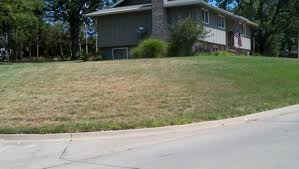Watering Lawns on Slopes

|
One of the most fundamental parts of keeping your lawn green and pretty during the hot summer months is to ensure that the water you are giving it is getting to the roots. This can be more complicated that you would think if you have slopes or hillsides in your lawn. When you water a hillside most of the water runs off instead of soaking down into the soil which can lead to dry, dead patches in your lawn. And once you have a dead patch of lawn or bare soil the problem gets bigger. |

|
The key to keeping your sloped lawn alive is to provide enough saturation when you water it and to prevent all the water from running off. That way the grass will get enough
water and will stay healthy and green.
The easiest way to do this is to break down your watering into short bursts of time instead of doing all of your watering at once. When the water first hits your lawn some will soak in, but as the ground gets wetter it will start to run off. By breaking down your watering into several sessions you can water just until the point that the water begins to run off and then stop and come back to water more later.
For this to be effective you need to work out how long to water, before the run off begins. Begin watering your slope and time how long it takes for the water on the ground to stop soaking in and start running down the slope. This is the longest that you can go for each watering cycle to ensure that the water is not just running down the hill. If it is 10 minutes that means that you may need to break your watering cycle into 3 parts to get 30 minutes of watering in.
It is important to do all of the watering cycles in one day instead of stretching them out over a week. Otherwise the water will not go deep enough into the soil and the roots won't get adequate moisture to keep your lawn alive and healthy. |
Fact: Watering on a slope or hillside is not complicated, it just takes a little more planning than watering a flat lawn or garden. |
By taking the time to break your watering cycle into smaller segments you will help your lawn get the water it needs and keep it looking fresh and green all
through the summer.
 Tip: Increase the amount of watering cycles if the grass at the top of the slope appears dry when the bottom of the slope is hydrated but not soggy.
Tip: Increase the amount of watering cycles if the grass at the top of the slope appears dry when the bottom of the slope is hydrated but not soggy.
2 Manually turn on your hose-end timer for a garden hose and sprinkler system, or the irrigation control for an in-ground irrigation system.
3 Write down the time you turn the system on.
4 Allow the lawn to receive water, and as soon as it starts to run off the bottom of the slope, manually turn off the timer.
5 Write down how many minutes you irrigated the lawn until the point of runoff at the bottom of the slope. Set your hose-end timer or irrigation controller so that it only turns on in cycles for the same amount of minutes until runoff occurs.
6 Measure the water depth in each container with a measuring tape. Each container should have about the same amount of water.
7 Determine how many irrigation cycles you need to run per week to administer about 1 inch of water per week to your lawn. For example, if the containers have about 1/8 inch of water in them, set your hose-end timer or irrigation controller to 8 cycles per week for the amount of time determined until runoff occurs.
Hide this content.

Tip: If the soil is particularly dry on sloping parts of the lawn, then use our wetting agent to get the water penetrating the soil in super fast time. See out products page for more info.
If you keep the roots happy then you will have a good lawn. What's above the ground reflects what is below the ground.Also see soil testing for more information.


